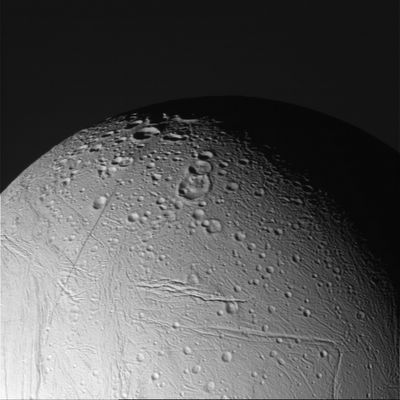Mapped moon, cracked moon, smacked Earth
Spectacular new pictures today of two of Saturn's moons from the Cassini mission:
- A large-scale photomosaic of the surface of Titan, by far the sharpest image ever of that enigmatic and strangely Earthlike frozen world. It shows Titan's dramatic, sweeping arc of what appears to be a coastline between a light continent and a vast dark sea -- which may be slush or swamp rather than open liquid, since it doesn't seem to show the mirrorlike reflections expected from a liquid surface. Sure, it may be water-ice continents by the shores of a liquid-methane sea, but it's certainly visually the most tantalizingly Earthlike other place we've ever seen.
- Close-up views of the totally frozen moon Enceladus, showing icy cracks and striations, including one long, straight dark crack that looks like the whole moon is cracking in two -- not possible, I'm sure, but it's a striking visual image.

Hot off the press: This is one of a set of new raw images taken during yesterday's encounter, the closest it will have with Enceladus.
Meanwhile, a fascinating new paper is appearing today in Nature (described in this press release), clinching the last bit of the century-long puzzle of Arizona's Meteor Crater (or Barringer Crater). It took more than half a century before the site was proved to be a meteor impact crater, but the mystery of what happened to most of the iron impactor has remained. H. Jay Melosh of U. of Az. seems to have solved the enigma, showing that the material spread out in small fragments because the object was travelling much less rapidly than had been assumed (only about 12 km/sec., close to the slowest possible impact speed). Nice detective work, mystery solved, case closed. Somewhere, Gene Shoemaker is smiling.

Aerial view of Meteor Crater, Arizona.
0 Comments:
Post a Comment
<< Home